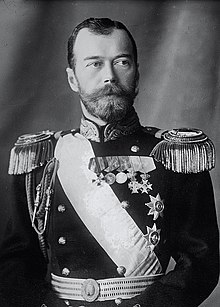
Back Nikolaas II van Rusland Afrikaans ዳግማዊ ኒኮላይ Amharic Nicolau II de Rusia AN Nicholas II Russena Casere ANG نيقولا الثاني إمبراطور روسيا Arabic نيكولاى التانى ARZ Nicolás II de Rusia AST II Nikolay Azerbaijani ایکینجی نیکولای (روسیه) AZB Николай II Bashkir
| Nicholas II | |||||
|---|---|---|---|---|---|
 Nicholas II in 1912 | |||||
| Emperor of Russia | |||||
| Reign | 1 November 1894[a] – 15 March 1917[b] | ||||
| Coronation | 26 May 1896[c] | ||||
| Predecessor | Alexander III | ||||
| Successor | Monarchy abolished | ||||
| Prime Ministers | See list | ||||
| Born | 18 May [O.S. 6 May] 1868 Alexander Palace, Tsarskoye Selo, Russian Empire | ||||
| Died | 17 July 1918 (aged 50) Ipatiev House, Yekaterinburg, Russian SFSR | ||||
| Cause of death | Murder | ||||
| Burial | 17 July 1998 | ||||
| Spouse | |||||
| Issue | |||||
| |||||
| House | Holstein-Gottorp-Romanov | ||||
| Father | Alexander III of Russia | ||||
| Mother | Dagmar of Denmark | ||||
| Religion | Russian Orthodox | ||||
| Signature |  | ||||
Nicholas II (Nikolai Alexandrovich Romanov;[d] 18 May [O.S. 6 May] 1868 – 17 July 1918) or Nikolai II was the last reigning Emperor of Russia, King of Congress Poland, and Grand Duke of Finland from 1 November 1894 until his abdication on 15 March 1917. He married Alix of Hesse (later Alexandra Feodorovna) in 1894 and had children Olga (1895), Tatiana (1897), Maria (1899), Anastasia (1901)—collectively known as the OTMA sisters—and the tsarevich Alexei Nikolaevich (1904).
During his reign, Nicholas gave support to the economic and political reforms promoted by his prime ministers, Sergei Witte and Pyotr Stolypin. He advocated modernisation based on foreign loans and close ties with France, but resisted giving the new parliament (the Duma) major roles. Ultimately, progress was undermined by Nicholas's commitment to autocratic rule, strong aristocratic opposition and defeats sustained by the Russian military in the Russo-Japanese War and World War I. By March 1917, public support for Nicholas had collapsed and he was forced to abdicate, thereby ending the Romanov dynasty's 304-year rule of Russia (1613–1917).
Nicholas signed the Anglo-Russian Convention of 1907, which was designed to counter Germany's attempts to gain influence in the Middle East; it ended the Great Game of confrontation between Russia and the British Empire. He aimed to strengthen the Franco-Russian Alliance and proposed the unsuccessful Hague Convention of 1899 to promote disarmament and peacefully solve international disputes. Domestically, he was criticised for his government's repression of political opponents and his perceived fault or inaction during the Khodynka Tragedy, anti-Jewish pogroms, Bloody Sunday and the violent suppression of the 1905 Russian Revolution. His popularity was further damaged by the Russo-Japanese War, which saw the Russian Baltic Fleet annihilated at the Battle of Tsushima, together with the loss of Russian influence over Manchuria and Korea and the Japanese annexation of the south of Sakhalin Island.
During the July Crisis of 1914, Nicholas supported Serbia and approved the mobilisation of the Russian Army on 30 July. In response, Germany declared war on Russia on 1 August and its ally France on 3 August, starting World War I. After several years of war, severe military losses led to a collapse of morale at the front and at home; a general strike and a mutiny of the garrison in Petrograd sparked the February Revolution and the disintegration of the monarchy's authority. After abdicating himself and on behalf of his son, Nicholas and his family were imprisoned by the Russian Provisional Government and exiled to Siberia. After the Bolsheviks seized power in the October Revolution, the family was held in Yekaterinburg, where they were executed in a basement on 17 July 1918.
In 1981, the Russian Orthodox Church Outside Russia, based in New York City, recognised Nicholas, his wife, and their children as martyrs. Their gravesite was discovered in 1979, but this was not acknowledged until 1989. After the fall of the Soviet Union, the remains of the imperial family were exhumed, identified by DNA analysis, and re-interred with an elaborate state and church ceremony in St. Petersburg on 17 July 1998, exactly 80 years after their deaths. They were canonised in 2000 by the Russian Orthodox Church as passion bearers. In the years following his death, Nicholas was reviled by Soviet historians and state propaganda as a "callous tyrant" who "persecuted his own people while sending countless soldiers to their deaths in pointless conflicts". Despite being viewed more positively in recent years, the majority view among historians is that Nicholas was a well-intentioned yet poor ruler who proved incapable of handling the challenges facing his nation.[1][2][3][4]
Cite error: There are <ref group=lower-alpha> tags or {{efn}} templates on this page, but the references will not show without a {{reflist|group=lower-alpha}} template or {{notelist}} template (see the help page).
- ^ "Восстановим историческую справедливость!". За-Царя.рф (in Russian). Archived from the original on 15 September 2024. Retrieved 17 February 2021.
- ^ Esthus, Raymond A. (1981). "Nicholas II and the Russo-Japanese War". Russian Review. 40 (4): 396–411. doi:10.2307/129919. ISSN 0036-0341. JSTOR 129919.
- ^ Ferro, Marc (1995) Nicholas II: Last of the Tsars. New York: Oxford University Press, ISBN 0-19-508192-7, p. 2
- ^ Warnes, David (1999). Chronicle of the Russian Tsars. Thames And Hudson. p. 163. ISBN 0-500-05093-7.